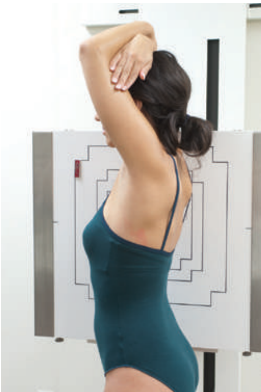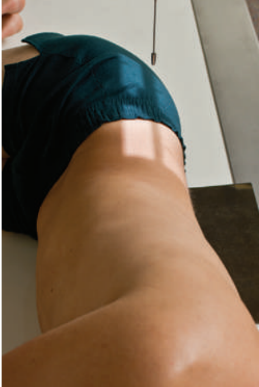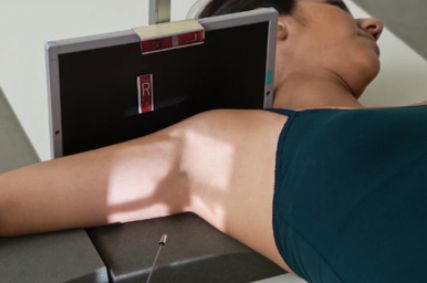radiograph
an image of a patient’s anatomic parts, as produced by the action of x-rays on an Image receptor.
radiography
the process and procedures of producing a radiograph.
image receptor
the device that captures the radiographic image that exits the patient.
central ray
refers to the centermost portion of the x-ray beam emitted from the x-ray tube.
anatomical position
a reference position that defines specific surfaces and planes of the body.
erect
forward
side
forward
together
straight
complete the context:
in an anatomical position, the body is BLANK with the face directed BLANK, the arms at the BLANK, and the palms of the hands facing BLANK, and the head and feet BLANK and directed BLANK ahead.
sagittal plane
longitudinal plane
divides the body into right and left parts
any plane parallel to the midsagittal or median plane
midsagittal plane
median plane
a midline sagittal plane that divides the body into equal right and left parts.
coronal plane
divides the body into anterior & posterior parts
any plane parallel to the midcoronal or frontal plane
midcoronal plane
divides the body into equaly anterior and posterior parts
because it passes approximately through the coronal suture of the skull
why is coronal plane called coronal plane?
horizontal (axial) plane
any transverse plane that passes through the body at right angles to a longitodinal plane
divides the body into superior and inferior portions
oblique plane
a longitudinal or transverse plane that is not parallel to the sagittal, coronal, or horizontal plane.
anterior
latin: before
towards the front of the body
posterior
latin: after
towards the back of the body
superior
latin: above
towards the top of the body
inferior
latin: below
towards the bottom of the body
medial
latin: middle
towards the midline
median
in the midline rather than towrds the midline
lateral
latin: side
away from the midline
proximal
latin: near
towards the center of the body
distal
latin: far
away from the center of the body
superficial
towards the surface of the body
deep
away from the surface of the body
ippsilateral
same side of the body
contralateral
opposite side of the body
flexion
movement
decrease in the angle of the joint
extension
movement
increase in the angle of the joint
abduction
movement of limb away from midline
adduction
movement of limb towards from midline
pronation
movement of hand and forearm to bring the palm facing posterior
supination
movement of hand and forearm to bring the palm facing anterior
circumduction
circular movement of a joint using a combination of flexion, abduction, extension and adduction such that the distal limb describes a circle
opposition
thumb brought to oppose another digit
reposition
thumb repositioned back to the anatomic position
elevation
movement of the scapular superioly
depression
movement of the scapular inferiorly
eversion
movement of the sole of the foot away from the median plane
inversion
movement of the sole of the foot towards from the median plane
protrusion
movement of the mandible, lips or tongue anteriorly
retraction
movement of the mandible, lips or tongue posteriorly
longitudinal sections (sagittal, coronal, and oblique)
these sections or images run lengthwise in the direction of the long axis of the body or any of its parts, regardless of the position of the body (erect or recumbent).
sagittal, coronal, or oblique plane.
longitudinal sections or images may be taken in, what plane/s?
sagittal, coronal, and transverse (axial)
CT, MRI, and Sonography images are obtained in these three common orientations or views.
base plane of skull
occlusal plane
planes of the skull
base plane of skull
plane of the skull
Frankfort Horizontal Plane
precise transverse plane is formed by connecting the lines from the infraorbital margins (inferior edge of bony orbits) to the superior margin of the external auditory meatus (EAM), the external opening
of the ear.
used in orthodontics and cranial topography to measure and locate specific cranial points or structures.
occlusal plane
plane of the skull
this horizontal plane is formed by the biting surfaces of the upper and lower teeth with jaws closed
used as a reference plane of the head for cervical spine and skull radiography
plantar
dorsal (foot, hand)
palmar
terms for surfaces of the hands and feet:
plantar
terms for surfaces of the hands and feet
refers to the sole or posterior surface of the foot.
dorsal foot (dorsum pedis)
terms for surfaces of the hands and feet
refers to the top or anterior surface of the foot, opposite the sole.
dorsal hand (dorsum manus)
terms for surfaces of the hands and feet
refers to the back or posterior surface of the hand; opposite the palm.
palmar
terms for surfaces of the hands and feet
refers to the palm of the hand;
in the anatomic position, the same as the anterior or ventral surface of the hand.
projection
a positioning term that describes the direction or path of the CR of the X-ray beam as it passes through the patient, projecting an image onto the IR.
Posteroanterior Projection
Anteroposterior Projection
AP Oblique Projection
PA Oblique Projection
Mediolateral & Lateromedial Projections
common projection terms:
posteroanterior (PA) projection
refers to a projection of the CR from posterior to anterior.
the CR enters at the posterior surface and exits at the anterior surface
Assumes a true PA without intentional rotation, which requires the CR to be perpendicular to the coronal body plane and parallel to the sagittal plane, unless some qualifying oblique or rotational term is used to indicate otherwise.
anteroposterior (AP) projection
refers to a projection of the CR from anterior to posterior.
opposite of PA
enters at an anterior surface and exits at a posterior surface
Assumes a true AP without rotation unless a qualifier term also
is used, indicating it to be an oblique projection.
AP oblique projection
This is not a true AP projection and must also include a qualifying term that indicates which way it is rotated, such as medial or lateral rotation
oblique
a projection of the upper or lower limb that is rotated is called, what?
AP oblique projection, medial rotation (from AP)
what is this?
PA oblique projection, lateral rotation (form PA)
what is this?
mediolateral projection (ankle)
what is this?
lateromedial projection (wrist)
what is this?

supine
prone
erect
recumbent
trendelenburg position
fowler’s position
sim’s position
lithotomy position
general body positions
supine
general body position
lying on back, facing upward
prone
general body position
lying on abdomen, facing downward
erect
general body position
an upright position, to stand or sit erect
recumbent
general body position
reclining
lying down in any position (prone, supine, or on side)
dorsal recumbent
general body position: recumbent
lying on back (supine)
ventral recumbent
general body position: recumbent
lying face down (prone)
lateral recumbent
general body position: recumbent
lying on side (right/left lateral)
trendelenburg position
general body position
a recumbent position with the body tilted with the head lower than the feet.
fowler’s position
general body position
a recumbent position with the body tilted with the head higher than the feet.
sim’s position
general body position
semiprone position
a recumbent oblique position with the patient lying on the left anterior side, with the right knee and thigh flexed and the left arm extended down behind the back.
modified sim’s position
a position used for insertion of the rectal tube for barium enema
lithotomy position
general body position
a recumbent (supine) position with knees and hip flexed and thighs abducted and rotated externally, supported by ankle supports.
seen frequently in surgical suite for certain urinary studies.
position
the term is used for general body positions
the term used in radiology to refer to a specific body position described by the body part closest to the IR (oblique and lateral) or by the surface on which the patient is lying (decubitus)
lateral position
specific body position
refers to the side or, or a side view
specific lateral positions described by the part closest to the IR or the body part from which the CR exits.
90°, or perpendicular, or at a right angle
a true lateral position is always, what, to a true AP or PA projection
oblique position
specific body position
refers to an angled position in which neither the sagittal nor the coronal body plane is perpendicular or at a right angle to the IR.
Left and Right Posterior Oblique (LPO and RPO) Positions
specific body position
also can be referred to as AP oblique projections
describe the specific oblique positions in which the left or right posterior aspect of the body is closest to the IR.
the CR exits from the left or right posterior aspect of the body.
LPO Position: The left side of the back is closest to the IR.
RPO Position: The right side of the back is closest to the IR.
because the CR enters an anterior surface and exits posteriorly.
why does LPO and RPO positions referred as AP oblique projection?
Right and Left Anterior Oblique (RAO and LAO) Positions
specific body position
refer to oblique positions in which the right or left anterior aspect of the body is closest to the IR and can be erect or recumbent general body positions.
RAO Position - the front right side of the body is closest to the imaging device (IR).
LAO Position - the front left side of the body is closest to the imaging device (IR).
decubitus
means to “lie down,” or the position assumed in “lying down.”
decubitus (decub) position
this body position, meaning to lie on a horizontal surface, is designated according to the surface on which the body is resting.
it is always performed with the central ray horizontal.
are essential for detecting air-fluid levels or free air in a body cavity such as the chest or abdomen, where the air rises to the uppermost part of the body cavity.
often performed if the patient cannot assume erect position.
Right or Left Lateral Decubitus Position
AP or PA Projection
In this position, the patient lies on the side, and the x-ray beam is directed horizontally from anterior to posterior (AP) or from posterior to anterior (PA)
right lateral decubitus position (PA projection)
what is this?
left lateral decubitus position (AP projection)
what is this?
Dorsal Decubitus Position—Left or Right Lateral
In this position, the patient is lying on the dorsal (posterior) surface with the x-ray beam directed horizontally, exiting from the side closest to the IR
The position is named according to the surface on which the patient is lying (dorsal or ventral) and by the side closest to the IR (right or left).
dorsal decubitus position (left lateral)
what projection is this?
ventral decubitus position (right lateral)
what is this?
erect right lateral position
what is this?

recumbent left lateral position
what projection is this?

erect left posterior oblique (LPO) postion
what is this?
recumbent left posterior oblique (LPO) position
what is this?
erect right anterior oblique position
what is this?
recumbent right anterior oblique (RAO) position
what is this?
axial projection
refers to the long axis of a structure or part (around which a rotating body turns or is arranged)
used to describe any angle of the CR of 10° or more along the long axis of the body or body part.
semiaxial
accurately describes any angle along the axis that is not truly perpendicular or parallel to the long axis.
AP axial (semiaxial) projection (CR 37° caudal)
what is this?
inferosuperior axial projections
frequently performed for the shoulder and hip, where the CR enters below or inferiorly and exits above or superiorly.
